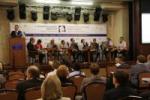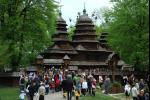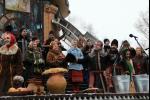As Part of Great Lithuanian Principality and Rich Pospolyta
The military-political movement of Lithuania and Poland to Ukrainian lands began in the 1330s and 1340s when the Lithuanian Grand Duke Liubard conquered Volyn. The assignment of the lands of the Halytsian-Volynian principality between two foreign states was completed by the Lithuanian-Polish War of 1351-1352, after which Halychyna proved to be under the power of the Polish King (later the West Volynian lands: Kholmian and Belzian, came under the Polish crown). The Podilia, Kyiv, Siver and Pereiaslav provinces also became parts of Lithuania under Liubard's successor: Grand Duke Olgerd. The local population did not resist Lithuanian expansion onto Ukrainian lands. It can be explained that Vilno did not try to break traditional socio-political institutions and the economic system which existed at that time. The state did not want to meddle in the spiritual life of the Ukrainian lands. It chose to intensively assimilate Ukrainian cultural and religious influences. In 1458, even separate Kyiv metropolia was formed, which was an additional impetus to the development of centrifugal tendencies in Ukrainian lands. The accessibility of Orthodox Kyiv to Western and Greek-Byzantine influences permitted the most important achievements of European civilization to be assimilated and adapted on the local ground.
Forced to resist the onset of German Knights and Golden Horde Khans, as well as the home opposition, the Lithuanian and Polish governments created an international union which was validated by the dynastic marriage. The Union conditions foresaw the incorporation of the Great Lithuanian Principality to the Polish Kingdom. At the same time, they took measures to politically centralize Lithuania. In particular, Volynian, Novhorod-Siverian, Podilian and Kyiv appanage principalities ceased to be independent. Now, they were subject to the vicars of the Grand Duke of Lithuania. In the future, notwithstanding certain successes, Ukrainian appanage princes did not manage to ever restore their past positions. For all that, the political and cultural influence of the local princes and boyars in the state was too considerable. In particular, the Ukrainian language was the official language of Lithuania. Traditional norms and bodies of self-administration were in force in the country. Vilno also had to reckon with the interests of the Ukrainian reigning elite when performing its home and foreign policy. All of that determined the relative internal stability of the Lithuanian-Russian state.
However, soon the Lithuanian-Catholic element began dominating within the state. Naturally, this called for certain resistance on the part of the home aristocracy. A whole number of revolts took place in the terrain of Ukrainian lands in the late 15th to early 16th centuries. Princes I. Olshanskyi, M. Olelkovych, F. Biliskyi (1481), and M. Glynskyi (1508) took part in these rebellions.








